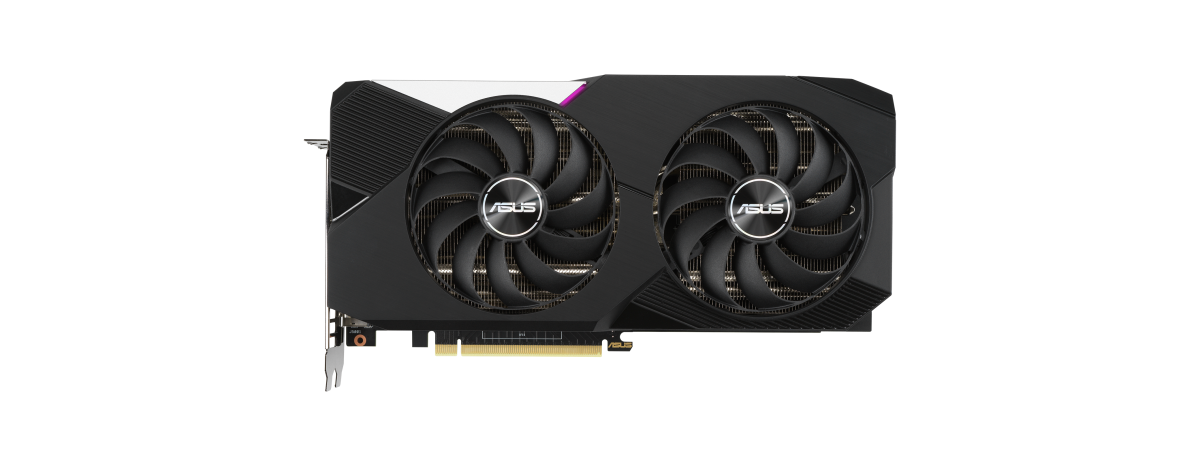
For me, one of AMD’s most compelling graphics cards these days is the Radeon RX 6800. And, as luck would have it, I got to test it this week. The RX 6800 targets the higher-end section of the gaming market, promising excellent performance in 1440p and even 4K resolutions. Built on the RDNA 2 architecture, it features 16 GB of GDDR6 RAM, fast bandwidth, and ray accelerators. Would you like to know more about what the AMD Radeon RX 6800 can do in real life? Then, read this review and find out:
AMD Radeon RX 6800: Who is it good for?
The AMD Radeon RX 6800 is a good choice for:
- Gamers who want an excellent graphics card for playing in 1440p or even 4K resolutions
- Team Red fans who want a powerful Radeon GPU with ray accelerators
- Anyone who’s looking for a GPU with low power consumption and efficient cooling
Pros and cons
There are many good things to consider when looking at the AMD Radeon RX 6800:
- It offers top-notch performance in gaming, in 1440p and above
- It’s built on the excellent AMD RDNA 2 architecture
- It comes with a lot of GDDR6 RAM (16 GB to be exact)
- Ray tracing performance is good, although Nvidia still has the edge
- The cooling system is efficient, and the power consumption is reasonable
- It's better than Nvidia’s Geforce RTX 3070 (which btw, costs more these days)

Verdict
The Radeon RX 6800 is one of AMD’s best products from the company’s latest graphics cards. Its performance in games is not on par with Nvidia’s Geforce RTX 3070 - it’s better. Delivering excellent numbers of frames per second both in 1080p and 1440p, and also in 4K, the Radeon RX 6800 is the gaming GPU I would buy today. Especially considering that its price in stores these days is lower than that of the Geforce RTX 3070, which doesn’t manage to match it in terms of speed. I warmly recommend the AMD Radeon RX 6800 graphics card to all our readers who enjoy gaming in 1440p or 4K resolutions.
Unboxing the AMD Radeon RX 6800
The ASUS ROG Strix RX 6800 is a large graphics card, so the box in which it arrives is quite oversized too. On it, you get to see a stylized image of the graphics card, focused on its cooler, as well as the name of the GPU. Minimalistic but stylish.

The box of the AMD Radeon RX 6800
Inside the box, I only found the graphics card - no documents or other goodies. However, that’s normal, as this is not a third-party implementation of the GPU. It’s the original Radeon RX 6800 graphics card, as made by AMD.

AMD Radeon RX 6800: What's inside the box
Unboxing the AMD Radeon RX 6800 reveals the graphics card in all its beauty. At first glance, I appreciate the fact that AMD chose to use a much better cooling solution than what I’ve seen in the past for the Radeon RX 5000 series of graphics cards.
Design and hardware specifications
The AMD Radeon RX 6800 has a design that’s almost identical to that of the more powerful Radeon RX 6800 XT and also similar to the one used by AMD on the Radeon RX 6700 XT. Just like the RX 6800 XT, the RX 6800 has three axial fans, an increase by one compared to the RX 6700 XT. Otherwise, the graphics cards follow the same lines with similar metal plates and the same black/silver gray colors. Oh, and on the edge of the GPU, there’s the subtle red LED-lit Radeon logo.

The cooler of the AMD Radeon RX 6800
The back of the AMD Radeon RX 6800 is covered by a metallic plate that protects the circuit board and helps toughen the card, so that it doesn’t bend under its own weight. In addition, it also dissipates some of the heat produced and looks good while doing it. 🙂

The backplate on the AMD Radeon RX 6800
AMD built the Radeon RX 6800 graphics card using the company’s latest architecture: RDNA 2. Although it uses the same 7-nanometer manufacturing process used on the first RDNA generation, RDNA 2 comes with more than just a few additional improvements, among which we can count better cache memory, larger bandwidth, better power efficiency, and ray accelerators for ray tracing.

Side view of the AMD Radeon RX 6800
The RX 6800 graphics card has 60 compute units, it is capable of computing up to 16.17 teraflops, and it benefits from 16 GB of GDDR6 memory on a 256-bit bus width. The game frequency is 1815 MHz, and the boost clock can reach 2105 MHz.

AMD Radeon RX 6800: Details shown by GPU-Z
The card runs on PCI Express 4.0 and features two standard DisplayPort 1.4a ports, one HDMI 2.1 port, and one USB-C port. By the way, the latter is nowhere to be found on Nvidia’s graphics cards.
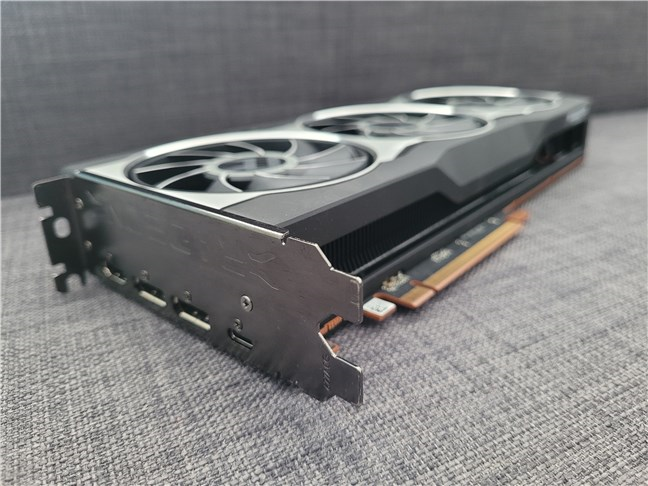
The output ports on the AMD Radeon RX 6800 graphics card
AMD says that the Radeon RX 6800 has a typical power need of up to 250 Watts and recommends a power supply unit of 650 Watts. The card uses two standard eight-pin connectors to get all the power it requires.

The power connectors on the AMD Radeon RX 6800
With a length of 26.7 cm (10.51 in), the AMD Radeon RX 6800 graphics card occupies two PCI slots. It’s a standard requirement for all gaming graphics cards these days.
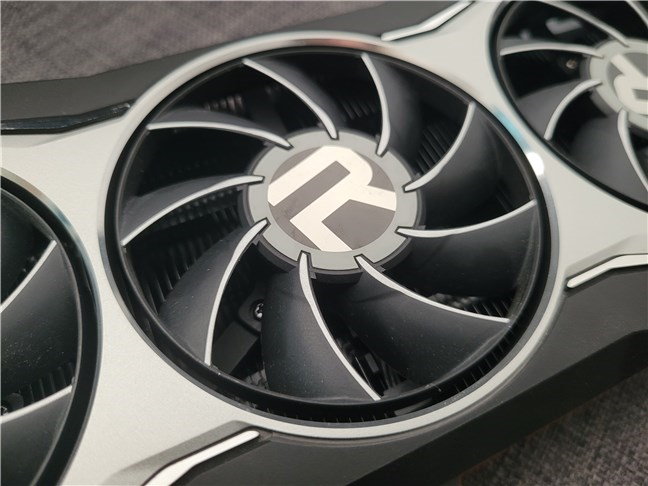
View of the cooler on the AMD Radeon RX 6800
If you want to check all the features and hardware specifications of this video card, visit AMD Radeon RX 6800.
Performance in games and benchmarks
To get a clear idea of what the AMD Radeon RX 6800 graphics card really offers in real life, I’ve run a couple of benchmarks. And I’ve also compared its results to those of an Nvidia GeForce RTX 3070. The computer we used for testing had the following configuration:
- Processor: AMD Ryzen 9 5900X
- Motherboard: ASUS ROG Crosshair VIII Hero (Wi-Fi)
- Memory: HyperX Predator DDR4 RGB (2 x 8 GB, 3200 MHz)
- Storage: Kingston KC3000 M.2 NVMe PCIe 4.0 2TB SSD
- Monitor: ASUS ROG Strix XG32VQ (2560x1440, 144Hz)
- Power Supply Unit: ASUS ROG Thor 850W Platinum
- CPU cooler: Cooler Master MasterLiquid ML360R RGB
- Operating System: Windows 11 Pro (version 21H2, build 22000.795)

The AMD Radeon RX 6800 GPU in my test computer
For the gaming benchmarks, I’ve used the high or ultra graphics settings presets, and I avoided enabling ray tracing on both cards in my testing. Also, I didn’t use DLSS on the Nvidia card or FSR on the AMD one. I wanted the raw performance results in gaming without the bells and whistles of ray tracing and upscaling features. Here’s what I found:
In Shadow of the Tomb Raider, a game that still looks gorgeous years after it was launched, the RX 6800 rendered 189 frames per second in 1080p resolution and 137 fps in 1440p. Compared to the Geforce RTX 3070, the RX 6800 is 15% to 18% better.

Benchmark results in Shadow of the Tomb Raider
Then, I checked Metro Exodus, which was also launched a couple of years ago but still requires very powerful hardware to run at top graphics quality. Here, the Radeon RX 6800 managed to deliver an average fps of 105 in 1080p and 87 fps in 1440p resolution. It proved to be faster than the RTX 3070, in both resolutions, by a margin of 9% to 27%.
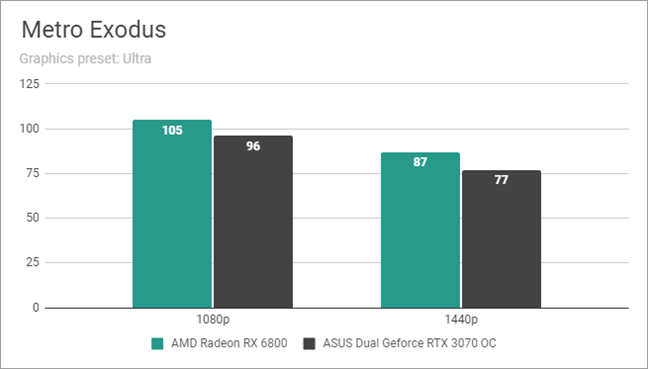
Benchmark results in Metro Exodus
Next, came Horizon Zero Dawn, one of my favorite games these last years. It, too, is a demanding game in terms of graphics performance. However, the Radeon RX 6800 had no issues in rendering an excellent number of frames per second. I measured an average of 152 fps in 1080p and 126 fps in 1440p. The GeForce RTX 3070 did well too, but was still weaker. The RX 6800 proved to be about 18% better in both resolutions tested.

Benchmark results in Horizon Zero Dawn
The third game I benchmarked was Assassin’s Creed Valhalla. Again, the RX 6800 proved to be significantly more powerful than the RTX 3070, delivering about 27% more frames per second, on average, in both 1080p and 1440p resolutions.

Benchmark results in Assassin's Creed Valhalla
The fourth and last game on my benchmarking list was Deathloop, a 2021 first-person shooter video game developed by Arkane Lyon and published by Bethesda Softworks. The game is special in its own way, standing out from the crowd in terms of gameplay and art design. It’s also quite taxing on the graphics card. With the Radeon RX 6800, I got 120 frames per second in 1080p and 96 fps in 1440p. That’s 9% to 10% more than what the Geforce RTX 3070 could deliver.

Benchmark results in Deathloop
Then, I turned to the synthetic graphics benchmarks offered by 3DMark. First, the Time Spy tests: the AMD Radeon RX 6800 managed a very impressive score of 15489 points, which is about 20% more than what the Geforce RTX 3070 got. However, in Port Royale, the second test I ran to evaluate the GPU performance in ray tracing, Nvidia’s Geforce RTX 3070 was slightly better - by 2.50% - than the Radeon RX 6800.
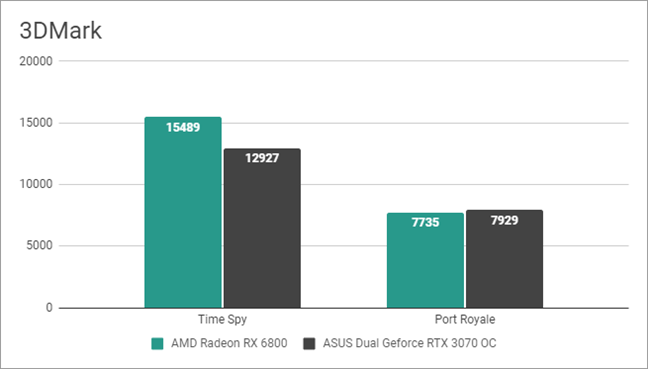
Benchmark results in 3DMark
During the benchmarks, I also kept an eye on the temperature and power consumption of the graphics cards. The AMD Radeon RX 6800 reached a maximum temperature of 78 degrees Celsius (172.4 Fahrenheit) and a peak power consumption of 203 Watts. Both values are good, especially considering that the average environment temperature when running the test was 29 degrees Celsius (84.2 Fahrenheit). Also, the Geforce RTX 3070 drew even more power than the Radeon RX 6800.

AMD Radeon RX 6800: Temperature and power consumption
The AMD Radeon RX 6800 is my favorite graphics card for 1440p gaming right now. It offers excellent performance in any game, no matter how demanding. Although I didn’t test it in 4K, I bet it can handle it too.
What is your opinion about the Radeon RX 6800 XT?
Now you know what the AMD Radeon RX 6800 can do: most important, it handles 1440p gaming easily. It should fare quite well in 4K resolutions as well. What do you think about it? Do you intend to get one for your gaming machine? Let me know in the comments section below.


 25.07.2022
25.07.2022 


